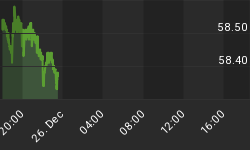This is the fourth week in a row where the "dumb money" is neutral and the "smart money" is bearish, and this is not a scenario that is generally supportive of higher prices especially with prices on the S&P500 under their 40 week moving average. The ideal situation for higher equity prices would be for the "smart money" to be bullish and the "dumb money" bearish (i.e., bull signal).
The "smart money" (see figure 1) refers to those investors and traders who make their living in the markets. Supposedly they are in the know, and we should follow their every move. The "smart money" indicator is a composite of the following data: 1) public to specialist short ratio; 2) specialist short to total short ratio; 3) SP100 option traders.
Figure 1. "Smart Money"
The "dumb money" or investment sentiment composite indicator (see figure 2, a weekly chart of the S&P500) looks for extremes in the data from 4 different groups of investors who historically have been wrong on the market: 1) Investor Intelligence; 2) Market Vane; 3) American Association of Individual Investors; and 4) the put call ratio.
Figure 2. "Dumb Money"
When combining the "dumb money" indicator with other metrics such as poor market internals and price under the 200 day moving average, we find that rallies tend to fail after 4 weeks of the "dumb money" indicator being neutral. We are now in that window where we expect the rally to stall.
Market participants remain hopeful to start the new year. The major indices have been driven higher on lackluster volume in anticipation of better times to come. Those hoping for a bottom can point to the market's persistence despite the bad economic news. They often make statements like: "the market is discounting the bad news and looking ahead" or "the market always bottoms before a recession ends". My response to such axiomatic dogma is two fold: 1) if the market is "all seeing", then what was the market thinking (or discounting) at the October, 2007 highs?; 2) the market bottomed almost 12 months after the 2001 recession ended so not all market bottoms occur at the trough of the recession.
Admittedly, the most bullish thing about the price action has been the price action. All the secondary indicators such as sentiment, volume or market internals have not mattered. Prices on the major indices have moved higher and key price levels have been met. The Russell 2000 and NASDAQ Composite have broken through resistance levels (albeit on sub par volume), and the S&P500 and Dow Jones Industrials have held at support and moved higher. This is all good - not only are prices headed higher but we know where are our points of failure (i.e., breaks of support).
But let's remember that this is still a bear market, and the winning strategy remains to sell hope and buy fear. We hope that the lackluster volume doesn't matter. We hope that increasing bullishness does not slow down the ascent of stock prices. We hope that breakouts don't turn into fake outs (which is a hallmark of bear markets). From this vantage point, the sentiment data I am presenting suggests that rallies are better selling opportunities.















